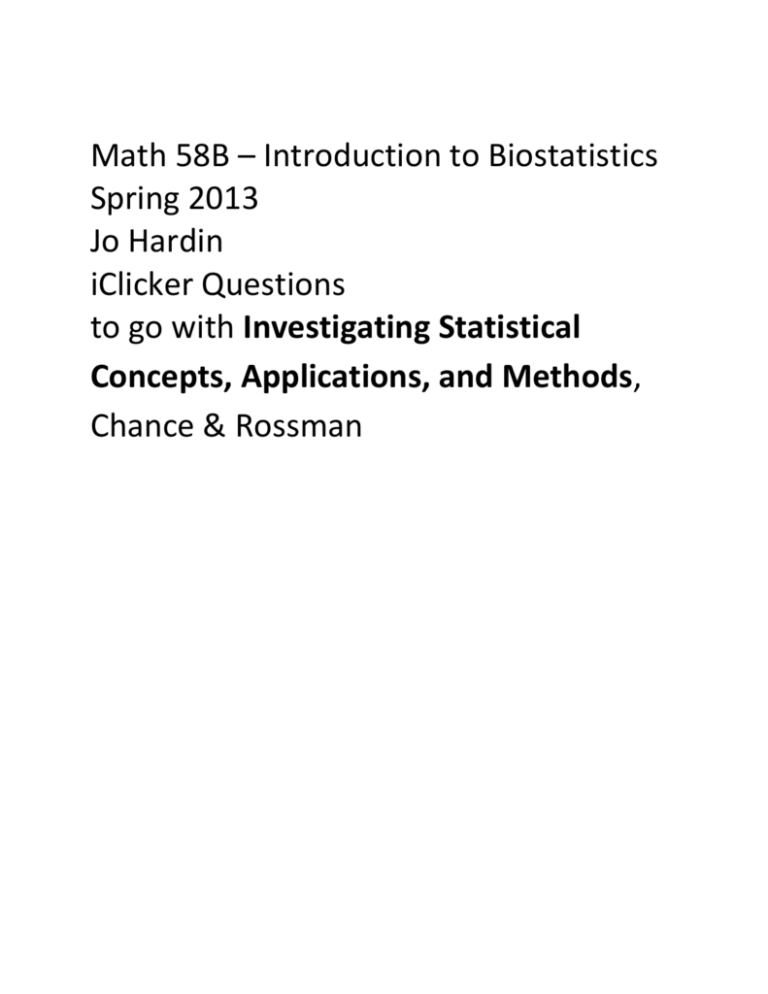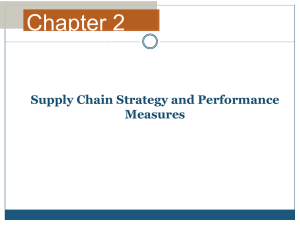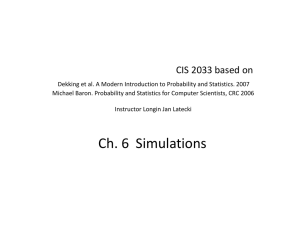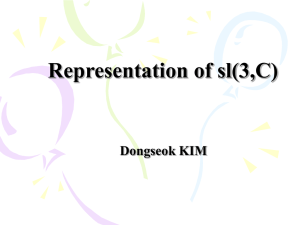Investigating Statistical Concepts, Applications
advertisement

Math 58B – Introduction to Biostatistics Spring 2013 Jo Hardin iClicker Questions to go with Investigating Statistical Concepts, Applications, and Methods, Chance & Rossman Inv 1.1 1. If 16 infants with no genuine preference choose 16 toys, what is the most likely number of “helping” toys that will be chosen? (a) 4 (b) 7 (c) 8 (d) 9 (e) 10 Inv 1.1 2. What percent of the time will the simulation flip exactly 8 coins? (a) (b) (c) (d) (e) 0-15% 16-30% 31-49% 50% 51-100% Inv 1.1 3. What if we flipped a coin 160 times? What percent of the time will the simulation flip exactly 80 coins? (a) 0-15% (b) 16-30% (c) 31-49% (d) 50% (e) 51-100% Inv 1.1 4. Is our actual result – under the null model – (a) Very surprising (b) Somewhat surprising (c) Not very surprising Binomial Probability Applet 1. Given the 5 question quiz set-up, how many different ways can you get 1 success? (a) 1 (b) 2 (c) 3 (d) 4 (e) 5 Binomial Probability Applet 2. Given the 5 question quiz set-up, how many different ways can you get 2 successes? (a) 5 (b) 7 (c) 10 (d) 15 (e) 20 Inv 1.4 3. In the kissing study, what is the variable of interest? (a) 124 pairs (b) Which direction they turn to kiss (c) The true probability of kissing to the right (d) Each couple (e) Each individual Inv 1.4 4. Before seeing the data, Dr. Gunturkun believes that ¾ of people kiss to the right. The null hypothesis is: (a) People are equally likely to kiss to the right as kiss to the left (b) People are more likely to kiss to the right (c) At least ¾ the people kiss to the right (d) More than ¾ of people kiss to the right (e) Exactly ¾ of people kiss to the right Inv 1.4 5. For the kissing study, are our actual data (under the null model: π=.75) (a) Very surprising (b) Somewhat surprising (c) Not very surprising Inv 1.4 6. For the kissing study, are our actual data (under the null model: π=2/3) (a) Very surprising (b) Somewhat surprising (c) Not very surprising Inv 1.4 7. Hypothesis: the number of hours that grade-school children spend doing homework predicts their future success on standardized tests. (a) null, one sided (b) null, two sided (c) alternative, one sided (d) alternative, two sided Inv 1.4 8. Hypothesis: king cheetahs on average run the same speed as standard spotted cheetahs. (a) null, one sided (b) null, two sided (c) alternative, one sided (d) alternative, two sided Inv 1.4 9. Hypothesis: the mean length of African elephant tusks has changed over the last 100 years. (a) null, one sided (b) null, two sided (c) alternative, one sided (d) alternative, two sided Inv 1.4 10. Hypothesis: the risk of facial clefts is equal for babies born to mothers who take folic acid supplements compared with those from mothers who do not. (a) null, one sided (b) null, two sided (c) alternative, one sided (d) alternative, two sided Inv 1.4 11. Hypothesis: caffeine intake during pregnancy affects mean birth weight. (a) null, one sided (b) null, two sided (c) alternative, one sided (d) alternative, two sided Inv 1.6 1. How many hits out of 20 at bats would make you believe him? (a) 5 (b) 6 (c) 7 (d) 8 (e) 9 Inv 1.6 2. Type I error is (a) We give him a raise when he deserves it. (b) We don’t give him a raise when he deserves it. (c) We give him a raise when he doesn’t deserve it. (d) We don’t give him a raise when he doesn’t deserve it. Inv 1.6 3. Type II error is (a) We give him a raise when he deserves it. (b) We don’t give him a raise when he deserves it. (c) We give him a raise when he doesn’t deserve it. (d) We don’t give him a raise when he doesn’t deserve it. Inv 1.6 4. Power is the probability that: (a) We give him a raise when he deserves it. (b) We don’t give him a raise when he deserves it. (c) We give him a raise when he doesn’t deserve it. (d) We don’t give him a raise when he doesn’t deserve it. Inv 1.6 5. The player is more worried about (a) A type I error (b) A type II error 6. The coach is more worried about (a) A type I error (b) A type II error Inv 1.6 7. Increasing your sample size (a) Increases your power (b) Decreases your power 8. Making your significance level more stringent (α smaller) (a) Increases your power (b) Decreases your power 9. A more extreme alternative (a) Increases your power (b) Decreases your power Inv 1.7 1. What are the observational units for your individual study? (a) Color of the candy (b) Piece of candy (c) Cup of candy (d) Hershey’s company (e) Proportion that are orange Inv 1.7 2. What are the observational units for the class compilation (dotplot)? (a) Color of the candy (b) Piece of candy (c) Cup of candy (d) Hershey’s company (e) Proportion that are orange Inv 1.7 3. How does the sampling distribution (“what if” distribution) change as n changes (for a fixed π)? (a) The spread changes (b) The symmetry changes (c) The center changes (d) The shape changes Inv 1.7 4. How does the sampling distribution (“what if” distribution) change as π changes (for a fixed n)? (a) The spread changes (b) The symmetry changes (c) The center changes (d) The shape changes Inv 1.7 5. The Central Limit Theorem says that the distribution of 𝑝̂ will be approximately normal with what center: (a) 𝑝̂ (b) π (c) 0 (d) 1 (e) √𝑛𝜋(1 − 𝜋) Inv 1.7 6. The Central Limit Theorem applies to a binomial situation as long as (technical conditions): (a) the trials are independent (b) n is fixed (c) the probability of success is constant for each trial (d) each trial is a success or failure (e) nπ ≥ 10 AND n(1-π) ≥10 (the other 4 already hold true because we have a binomial setting) Inv 1.10 1. For the kissing data, let’s pretend n = 100 and we know π= 0.8 (𝑛𝑜𝑡𝑒: √(0.8 ∗ 0.2)/100 = 0.4 10 = 0.04). Which statement is true? (a) 95% of 𝑝̂ are between (0.76, 0.84) (b) 95% of 𝑝̂ are between (0.72, 0.88) (c) 95% of 𝑝̂ are between (0.68, 0.92) (d) 95% of π are between (0.76, 0.84) (e) 95% of π are between (0.72, 0.88) Inv 1.10 2. Let’s say we are making confidence intervals (not doing a hypothesis test), what is your best guess for SD(𝑝̂ )? (a) √ 0.5(1−0.5) 𝑛 (b) √ (c) √ 𝜋(1−𝜋) 𝑛 𝑝̂(1−𝑝̂) 𝑛 (d) √ (e) √ 𝑋(1−𝑋) 𝑛 0.95(1−0.95) 𝑛 Inv 1.10 3. If you want a 90% confidence interval for π, your z* multiplier should be (a) less than 1 (b) less than 2 (but greater than 1) (c) equal to 2 (d) greater than 2 (but less than 3) (e) greater than 3 Inv 1.10 4. Let’s say that the null hypothesis (e.g., π=0.47) is TRUE. My level of significance is 0.03. How often will I reject the null hypothesis? (a) 1 % of the time (b) 3% of the time (c) 5 % of the time (d) 95% of the time (e) 97% of the time Inv 1.10 5. Let’s say that the null hypothesis (e.g., π=0.47) is TRUE. My level of significance is 0.03. How often will π be in a 97% confidence interval? (a) 1 % of the time (b) 3% of the time (c) 5 % of the time (d) 95% of the time (e) 97% of the time Inv 1.12 1. Suppose that you take many random samples (i.e., thousands) from a population and graph the distribution of the resulting sample statistics. If the distribution of sample statistics is centered around the value of the population parameter then is the sampling distribution of the statistic unbiased? (a) Yes, definitely (b) Maybe or maybe not (c) No, definitely not If we’re talking about the statistic, unbiased means that the sampling distribution is centered in the right place. Inv 1.12 2. Suppose that you take many random samples (i.e., thousands) from a population and graph the distribution of the resulting sample statistics. If the distribution of sample statistics appears to be normally distributed then is the sampling distribution of the statistic unbiased? (a) Yes, definitely (b) Maybe or maybe not (c) No, definitely not Certainly, the curve could be shifted over. Inv 1.12 3. Suppose that you take many random samples (i.e., thousands) from a population and graph the distribution of the resulting sample statistics. If most of the sample statistics are close to the value of the population parameter, then is the sampling distribution of the statistic unbiased? (a) Yes, definitely (b) Maybe or maybe not (c) No, definitely not The values of the statistic could be close but all less than the parameter (that would be bias). Inv 1.12 4. Suppose that you take many random samples (i.e., thousands) from a population and graph the distribution of the resulting sample statistics. If the sampling method is biased, then will increasing the sample size reduce the bias? (a) Yes, definitely (b) Maybe or maybe not (c) No, definitely not The only time that (b) is possibly true is if the sample size approaches the population size (which doesn’t typically happen when we think of really huge populations). Inv 1.12 5. Which of the following are advantages of studies with a larger sample size (more than one may be right). (a) Better represent the population (reduce sampling bias) (b) More accurately estimate the parameter (c) Decrease sampling variability of the statistics (d) Make simulation results more accurate for the theoretical results given the sampling method at hand. (e) other? Inv 1.12 6. In conducting a simulation analysis, why might we take a larger number of samples? (more than one may be right). (a) Better represent the population (reduce sampling bias) (b) More accurately estimate the parameter (c) Decrease sampling variability of the statistic (d) Make simulation results more accurate for the theoretical results given the sampling method at hand. (e) other? Inv 2.1 1. When doing a hypothesis test for H0: π1 - π2 = 0 Our best guess for 𝜋1 is: (a) 𝑝 ̂1 = (𝑏) 𝑝 ̂2 = (c) 𝑝̂ = (d) 0 𝑋1 𝑛1 𝑋2 𝑛2 𝑋1 + 𝑋2 𝑛1 + 𝑛2 Inv 2.1 2. Based on the night light / myopia example, we can conclude: (a) if the p-value is small, sleeping in a lit room makes it more likely that you are near-sighted. (b) if the p-value is small, sleeping in a dark room makes it more likely that you are near-sighted. (c) if the p-value is small, a higher proportion of near-sighted children sleep in lit rooms than the proportion of not near-sighted children. (d) because plit room = 188/307 = 0.612 and pdark = 18/172 = 0.105, we know that sleeping with the light on is bad for you. Inv 2.1 3. A possible confounding variable for the night light study is: (a) low birth weight (b) race (70% of the children were Caucasian) (c) region of the country where the clinic was located Inv 2.3 1. A possible confounding variable for the handwriting study is: (a) grade of the student (age) (b) region of country where the SAT was taken (c) academic ability of the student (d) gender of the student (e) number of siblings of the student. 1. A Sampling distribution is (a) The true distribution of the data (b) The estimated distribution of the data (c) The distribution of the population (d) The distribution of the statistic in repeated samples (e) The distribution of the statistic from your one sample of data Inv 2.4 1. The main reason we randomly assign the explanatory variable is: (a) To get the smallest p-value possible (b) To balance the expected causal mechanism across the two groups (c) To balance every possible variable (d) So that our sample is representative of the population (e) So that the sampling process is unbiased Inv 2.4 2. The main reason we take random samples from the population is: (a) To get the smallest p-value possible (b) To balance the expected causal mechanism across the two groups (c) To balance every possible variable across the two groups (d) So that our sample is representative of the population (e) So that the sampling process is unbiased Inv 2.4 3. The “random” part in clinical trials typically comes from: (a) random samples (b) random allocation of treatment Inv 2.4 4. The “random” part in polling typically comes from: (a) random samples (b) random allocation of treatment Inv 2.6 1. What does “by random chance” (in calculating the p-value) mean here? (a) random allocation (b) random sample Inv 2.6 2. “Our data or more extreme” is: (a) fewer than 10 (b) 10 or fewer (c) 10 or more (d) more than 10 Inv 2.6 3. What is the mean value of the null sampling distribution for the number of dolphin therapy who showed substantial improvement? (a) 0 (b) 6.5 (c) 10 (d) 15 Inv 2.9 1. Relative Risk is (a) the difference of two proportions (b) the ratio of two proportions (c) the log of the ratio of two proportions (d) the log of the difference of two proportions Inv 2.9 2. One reason we should be careful interpreting relative risks is if: (a) we don’t know the difference in proportions (b) we don’t know the SE of the relative risk (c) we might be dividing by zero (d) we don’t know the absolute risk Inv 2.9 3. In finding a CI for π1/π2, why is it okay to exponentiate the end points of the interval for ln(π1/π2)? (a) Because if ln(π1/π2) is in the original interval, π1/π2 will be in the exponentiated interval. (b) Because taking the natural log of the RR makes the distribution approximately normal. (c) Because the natural log compresses values that are bigger than 1 and spreads values that are smaller than 1. (d) Because we can get exact p-values using Fisher’s Exact Test. Inv 2.10 1. When we select individuals based on the explanatory variable, we cannot accurately measure (a) the proportion of people in the population in each explanatory category (b) the proportion of people in the population in each response group (c) anything about the population (d) confounding variables Inv 2.10 2. The odds ratio is invariant to which variable is explanatory and which is response means: (a) we always put the bigger odds in the numerator (b) we must collect data so that we can estimate the response in the population (c) which variable is called the explanatory changes the value of the OR (d) which variable is called the explanatory does not change the value of the OR Inv 2.11 3. In order to find a CI for the true OR, our steps are: 1. ln(OR) 2. add ± z* sqrt( 1/A + 1/B + 1/C + 1/D) 3. find exp of the endpoints (a) because the sampling distribution of OR is normal (b) because OR is typically greater than 1 (c) because the ln transformation makes the sampling distribution almost normal (d) because OR is invariant to the choice of explanatory or response variable Inv 3.2 1. The standard deviation of weights (mean = 167 lbs) is approximately (a) 1 (b) 5 (c) 10 (d) 35 (e) 100 Inv 3.2 2. The standard deviation of average weights (mean = 167 lbs) in a sample of size 10 is approximately (a) 1 (b) 5 (c) 10 (d) 35 (e) 100 Inv 3.2 3. The standard deviation of average weights (mean = 167 lbs) in a sample of size 50 is approximately (a) 1 (b) 5 (c) 10 (d) 35 (e) 100 Inv 3.2 4. The standard deviation of average weights (mean = 167 lbs) in a sample of size 1000 is approximately (a) 1 (b) 5 (c) 10 (d) 35 (e) 100 Inv 3.2 5. The sampling distribution of the mean will be (a) centered below the data distribution (b) centered at the same place as the data distribution (c) centered above the data distribution (d) unrelated to the center of the data distribution Inv 3.2 6. The sampling distribution of the mean will be (a) less variable than the data distribution (b) the same variability as the data distribution (c) more variable than the data distribution (d) unrelated to the variability of the data distribution Inv 3.2 7. Why did we switch from talking about total weight to talking about average weight? (a) So that it is easier to infer from the sample to the population. (b) Because the Coast Guard certifies vessels according to average weight. (c) Because the average is less variable than the sum. (d) Because the average has a normal distribution and the sum doesn’t. Inv 3.2 8. What does the CLT say? That for a large enough sample, the sampling distribution of the average will have a normal distribution regardless of the underlying population from which the data came. https://www.youtube.com/watch?v=ez4DgdurRPg Inv 3.4 & 3.5 1. We typically compare means instead of medians because (a) we don’t know the SE of the difference of medians (the SE isn’t easy to calculate, but for many distributions we can estimate it or calculate it directly) (b) means are inherently more interesting than medians (c) the randomization applet (or R code) doesn’t work with medians (d) the Central Limit Theorem doesn’t apply for medians. (The reason this is important is because we need to know what the null distribution is if we want to calculate p-values without simulations.) Inv 3.4 & 3.5 2. SE(𝑋̅1 − 𝑋̅2 )is (a) √ 𝜎12 𝑛1 (b) √ (c) √ 𝜎12 𝑛1 𝑠12 𝑛1 (d) √ 𝑠12 𝑛1 + − + − 𝜎22 𝑛2 𝜎22 𝑛2 𝑠22 𝑛2 𝑠22 𝑛2 Inv 3.6 & 3.7 1. Are the two samples (lefties and righties) independent? (a) yes (well, we don’t really know that they are independent, but it seems like a very reasonable assumption) (b) no (c) we can’t tell Inv 3.6 & 3.7 2. What would you expect the standard deviation of the t statistic to be if the null hypothesis is true? (a) a little bit less than 1 (b) 1 (c) a little bit more than 1 (d) unable to tell because it depends on the sample size and the variability of the data 3. Inv 3.7 (i) Which p-value is smaller? (a) 2 (b) 3 You should be able to answer without calculating the t-statistic. (ii) Which p-value is smaller? (a) 3 (b) 4 You should be able to answer without calculating the t-statistic. Inv 3.6 & 3.7 4. How does each affect the power? (i) increasing the sample sizes of both groups (a) increases the power (b) doesn’t change the power (c) decreases the power (ii) increasing the variability within the groups (a) increases the power (b) doesn’t change the power (c) decreases the power (iii) increasing the difference in actual (population) group means (a) increases the power (b) doesn’t change the power (c) decreases the power Inv 3.9 1. Should we do a two sample t-test of means? (a) No, the samples are too small. (b) No, the data aren’t normal. (c) No, we don’t know the true population variances. (d) No, we don’t know the true population means. (e) Yes, all the assumptions are met. Really, the problem is that the samples are too small AND the data aren’t normal. We need one of those things to change. Inv 3.10 / 3.11 1. What is the primary reason to use a matched pairs design? (a) To increase the sample size (b) To ensure that not everyone melts the chocolate chip first (c) To reduce the variability (d) To find a better estimate of µ1 - µ2 Inv 3.10 & 3.11 2. A farmer wants to see whether referring to cows by name increases their milk production. He selects half of his cows at random, gives them names, and frequently calls them by name. The other half of his cows he does not call by name. Then he measures the milk production of each cow over a one-week period. (a) paired (b) independent Inv 3.10 & 3.11 3. A farmer wants to know whether handmilking or machine-milking tends to produce more milk from cows. He examines records of how much milk the cows have produced in the past, and orders them from most to least productive. For the top two milk producers, randomly assign one to hand-milking and the other to machine-milking. Do the same for the next two and the next two and so on. (a) paired (b) independent Inv 3.10 & 3.11 4. You wonder whether students at your school tend to drive newer cars than faculty at your school. You take a random sample of 20 students and a random sample of 10 faculty members, and ask each person how old their car is. (a) paired (b) independent Inv 3.10 & 3.11 5. To investigate whether awareness that firstyear college students tend to gain weight during their first year affects their weight gain, fall quarter you randomly assign one dorm to put up signs about “avoiding the freshmen 15” but not in a second dorm. At the end of the term you compare the weight gain of students in the two dorms. (a) paired (b) independent (not a simple random sample, though) Inv 3.10 & 3.11 6. What if you switch the signs the second term? (a) paired (though you definitely have a bias because of who went first) (b) independent Review 1. The standard deviation measures (a) The distance from the sample mean corresponding to 68% of the data. (b) The average distance of a point to the sample mean (the average distance of a point to the sample mean is zero) (c) The square of the distance from a point to the sample mean (d) A usual distance of a point to the sample mean Review 2. The line in the interior of the box on a boxplot is (a) The mode (b) The mean (c) The median (d) The IQR Review 3. Given the situation where Ha is TRUE. Consider 100 CIs (for true difference in means), the power of the test can be approximated by: (a) The proportion that contain the true difference in means. (b) The proportion that do not contain the true difference in means. (c) The proportion that contain zero. (d) The proportion that do not contain zero. Remember, the power is how often we will reject H0 when we should. Inv 3.12 1. Given the body temp data, can we tell if the technical conditions are met for applying tprediction intervals n Min 130 96.3 Q1 Median Q3 97.8 98.3 Max Mean 98.7 101 SD 98.2 0.733 (a) No (b) We can’t tell because we need to know if the distribution of the data is normal. (c) Yes, the mean is very close to the median. (d) Yes, the sample size is large. (e) Yes, the standard deviation isn’t very big. Inv 3.12 & 3.14 2. The variance of the individual observations (a) is smaller than the variance of the sample mean (b) is about the same as the variance of the sample mean (c) is larger than the variance of the sample mean (d) is not related to the variance of the sample mean Inv 3.12 & 3.14 3. Prediction intervals are (a) smaller than confidence intervals (b) about the same width as confidence intervals (c) larger than confidence intervals (d) unrelated to confidence intervals Inv 3.12 & 3.14 4. Prediction intervals have (a) the same technical conditions as CIs (b) stricter technical conditions than CIs (c) more lenient technical conditions than CIs (d) technical conditions which are unrelated to CIs Inv 4.1 1. null hypothesis: H0: π1 = π2 = π3 = π4 = π5 = π6 = π7 What is the alternative hypothesis? (a) Ha: π1 = π2 = π3 = π4 = π5 = π6 = π7 = 0 (b) Ha: π1 ≠ π2 ≠ π3 ≠ π4 ≠ π5 ≠ π6 ≠ π7 (all probabilities are unequal) (c) Ha: π1 = π2 = π3 = π4 = π5 = π6 ≠ π7 (one probability is different) (d) Ha: at least one probability is different Inv 4.1 2. If the null hypothesis is true, the observed counts should equal the expected counts. (a) True (b) False (there should always be some variability) Inv 4.1 3. To reject the null hypothesis we want to see (a) a small X2 value (b) a big X2 value Inv 4.1 4. A chi-square test is (a) one-sided, and we only consider the upper end of the sampling distribution (b) one-sided, and we consider both ends of the sampling distribution (c) two-sided, and we only consider the upper end of the sampling distribution (d) two-sided, and we consider both ends of the sampling distribution Inv 4.3 1. For the newspaper setting, which variable is the explanatory variable? (a) type of newspaper (b) believability score (c) year (d) individual person Inv 4.3 2. If we sample randomly from a population, the conclusions we can make are about: (a) causation (b) population characteristics Inv 4.3 3. homogeneity of proportions means (a) the proportion of obs units who have some response (e.g., believe = 4) is the same across all explanatory variables. (b) each response is equally likely for any explanatory variable (c) the variables are independent (this is also true, however, if we have homogeneity of proportions) (d) a & c (e) b & c Inv 4.3 4. Independence between two categorical variables means: (a) one does not cause the other (b) knowledge of one variable does not tell us anything about the probability associated with the other variable (c) as one variable increases, the other variable increases (d) as one variable increases, the other variable decreases Inv 4.4 1. In order to tell whether the differences in sample means are significant, we need to ALSO know: (a) how variable the observations are (b) the distribution of the observations (the ANOVA model assumes normality. However, the test is reasonably robust to deviations from normality, especially if the sample sizes are constant and the variability is constant) (c) the sample sizes (d) all of the above (e) some of the above Inv 4.4 2. In the ANOVA setting, the null hypothesis is always: H0: µ1 = µ2 = µ3 = … = µk What is the alternative hypothesis? (a) Ha: at least one µi is different (b) Ha: µ1 ≠ µ2 ≠ µ3 ≠ … ≠ µk (c) Ha: µ1 = µ2 = µ3 = … = µk = µ (for some µ value) (d) Ha: at least one µi is substantially different (it violates the null hypothesis even if it is only a tiny bit different) Inv 4.4 3. We reject the null hypothesis if: (a) the between group variability is much bigger than the within group variability (b) the within group variability is much bigger than the between group variability (c) the within group variability and the between group variability are both quite large (d) the within group variability and the between group variability are both quite small Inv 4.7 1. Suppose that we record the midterm exam score and the final exam score for every student in a class. What would the value of the correlation coefficient be if every student in the class scored ten points higher on the final than on the midterm: (a) r = -1 (b) -1 < r < 0 (c) r = 0 (d) 0 < r < 1 (e) r = 1 Inv 4.7 2. Suppose that we record the midterm exam score and the final exam score for every student in a class. What would the value of the correlation coefficient be if every student in the class scored five points lower on the final than on the midterm: (a) r = -1 (b) -1 < r < 0 (c) r = 0 (d) 0 < r < 1 (e) r = 1 Inv 4.7 3. Suppose that we record the midterm exam score and the final exam score for every student in a class. What would the value of the correlation coefficient be if every student in the class scored twice as many points on the final than on the midterm: (a) r = -1 (b) -1 < r < 0 (c) r = 0 (d) 0 < r < 1 (e) r = 1 Inv 4.7 4. Suppose you guessed every value correctly (guess the correlation applet), what would be the value of the correlation coefficient between your guesses and the actual correlations? (a) r = -1 (b) -1 < r < 0 (c) r = 0 (d) 0 < r < 1 (e) r = 1 Inv 4.7 5. Suppose each of your guesses was too high by 0.2 from the actual value of the correlation coefficient, what would be the value of the correlation coefficient between your guesses and the actual correlations? (a) r = -1 (b) -1 < r < 0 (c) r = 0 (d) 0 < r < 1 (e) r = 1 Inv 4.7 6. A correlation coefficient equal to 1 indicates that you are a good guesser. (a) TRUE (b) FALSE Inv 4.8 1. When writing the regression equation, why do we put a hat ( ^) on the response variable? (a) because the prediction is an estimate (b) because the prediction is an average (c) because the prediction may be due to extrapolation (d) (a) & (b) (e) all of the above Inv 4.8 2. If there is no relationship in the population (true correlation = 0), then r=0 (a) TRUE (b) FALSE Inv 4.8 3. If there is no relationship in the population (true slope = 0), then b1=0 (a) TRUE (b) FALSE Inv 4.10 1. The regression technical assumptions include: (a) The Y variable is normally distributed (Y is only normally distributed AROUND THE LINE) (b) The X variable is normally distributed (c) The residuals are normally distributed (d) The slope coefficient is normally distributed (e) The intercept coefficient is normally distributed Inv 4.12 2. A larger variability around the regression line (σ): (a) increases the variability of b1. (b) decreases the variability of b1. (c) doesn’t necessarily change the variability of b1. Inv 4.12 3. A larger variability in the explanatory variable (SD(X)): (a) increases the variability of b1. (b) decreases the variability of b1. (c) doesn’t necessarily change the variability of b1. Inv 4.12 4. A larger sample size (n): (a) increases the variability of b1. (b) decreases the variability of b1. (c) doesn’t necessarily change the variability of b1. Inv 4.11 5. We transform our variables… (a) … to find the highest r^2 value. (b) … when the X variable is not normally distributed. (c) … to make the model easier to interpret. (d) … so that the technical conditions are met.







